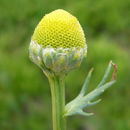Comments
provided by eFloras
E. McClintock (1993b) reported Matricaria occidentalis as being used as a substitute for chamomile. In California, the species is found in the Coast Ranges to the South Coast, in parts of the San Joaquin Valley, and in the High Cascade, Sierra Nevada, and Desert Ranges and surrounding areas. Although listed as secure, the species appears to have been eradicated from some counties in California and its range may be shrinking due to disappearance of its habitat.
- license
- cc-by-nc-sa-3.0
- copyright
- Missouri Botanical Garden, 4344 Shaw Boulevard, St. Louis, MO, 63110 USA
Description
provided by eFloras
Annuals, 8–45(–70) cm; not notably aromatic. Stems 1–5+, usually erect, sometimes ascending, simple or branched mostly distally, sometimes proximally (then ascending). Leaf blades 1560(–80) × 5–28 mm. Heads discoid, 1–15+, borne singly or in open, corymbiform arrays. Peduncles 1–56(–90) mm (glabrous or villosulous near heads, bracts 0–3, simple or 1-pinnate). Involucres 3.5–4.5 mm. Phyllaries 25–55+ in 3–4 series, margins erose. Receptacles 4.5–6.6 mm, rounded to obtuse or ± acute. Ray florets 0. Discs ovoid to hemispheric, 5.5–12.5 × 6–14 mm. Disc florets 400–750+; corollasgreenish yellow, 1.2–1.7 mm (sparsely glandular), lobes 4. Cypselae tan to brownish, obtriangular-obconic (angular, abaxial faces rounded, adaxial faces slightly convex), 1–1.5 mm, ribs white (2 abaxial, 2 lateral, each with reddish brown mucilage gland in distal 1/2, glands expanding into lobes, 1 adaxial, usually obscure, sometimes with a gland), faces not glandular; pappi coroniform, lobed (lobes 2, spreading, abaxio-lateral, ± obtuse to rounded). 2n = 18.
- license
- cc-by-nc-sa-3.0
- copyright
- Missouri Botanical Garden, 4344 Shaw Boulevard, St. Louis, MO, 63110 USA
Synonym
provided by eFloras
Chamomilla occidentalis (Greene) Rydberg
- license
- cc-by-nc-sa-3.0
- copyright
- Missouri Botanical Garden, 4344 Shaw Boulevard, St. Louis, MO, 63110 USA
Comprehensive Description
provided by North American Flora
Chamomilla occidentalis (Greene) Rydberg
Matricaria occidentalis Greene. Bull. Calif. Acad. 2: 150. 18S7.
A very leafy stout annual; stem 3-7 dm. high, angled, branched; leaves 3-6 dm. long, glabrous, bior tri-pinnatifid, with linear-filiform fleshy segments; heads in leafy corymbs, discoid; involucre saucer-shaped, 4 mm. high, 8-12 mm. broad; bracts subequal, in 2-3 series, elliptic, rounded at the apex, with white scarious margins; receptacle conic, acute, hollow; ray-flowers wanting; disk-corollas greenish-yellow, 1.5 mm. long; tube somewhat gibbous, longer than the campanulate throat; lobes 4, ovate; achenes 1.5 mm. long, 4-angled on the inner side, smooth on the back and between the ribs; pappus-crown with two lateral darkbrown conspicuous lobes.
Type locality: Grain fields of the lower San Joaquin and Sacramento region, California.
Distribution: Middle California to southern Oregon.
- bibliographic citation
- Per Axel Rydberg. 1916. (CARDUALES); CARDUACEAE; TAGETEAE, ANTHEMIDEAE. North American flora. vol 34(3). New York Botanical Garden, New York, NY
Matricaria occidentalis: Brief Summary
provided by wikipedia EN
Matricaria occidentalis, commonly known as valley mayweed, is an annual plant native to North America. It is in the family Asteraceae.
- license
- cc-by-sa-3.0
- copyright
- Wikipedia authors and editors

